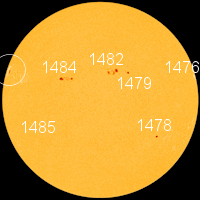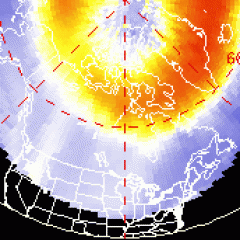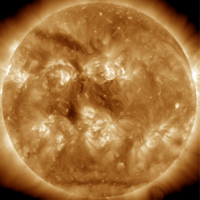~Space Weather Update~ Glancing Blow CME Arriving~ [1]
INCOMING CME? A coronal mass ejection (CME) that flew off the sun's western limb on May 17th might hit Earth after all. NOAA forecasters say a shock wave from the blast could deliver a glancing blow to Earth's magnetic field on May 18th or 19th. The CME, pictured below, was propelled by an M5-class [2] solar flare from departing sunspot AR1476.
The speckles in the movie [3] are caused by energetic protons hitting the observatory's detector. Those protons may have been accelerated in part by the shock wave en route to Earth.
According to NOAA, there is a 40% chance of minor geomagnetic storms and a 15% chance of strong storms when the shock arrives. High-latitude sky watchers should be alert for auroras. CME alerts: text [4], phone [5].

![]()
Solar wind
speed: 417.5 km/sec
density: 5.9 protons/cm3
explanation [6] | more data [7]
Updated: Today at 1714 UT
![]()
X-ray Solar Flares
6-hr max: C2 1347 UT May18
24-hr: C3 0823 UT May18
explanation [8] | more data [9]
Updated: Today at: 1700 UT
![]()
![]()
![]()
Daily Sun: 18 May 12
![]()
![]()
A new sunspot is emerging at the circled location. Credit: SDO/HMI
![]()
![]()
![]()
Sunspot number: 114
What is the sunspot number? [11]
Updated 17 May 2012
Spotless Days
Current Stretch: 0 days
2012 total: 0 days (0%)
2011 total: 2 days (<1%)
2010 total: 51 days (14%)
2009 total: 260 days (71%)
Since 2004: 821 days
Typical Solar Min: 486 days
Updated 17 May 2012
The Radio Sun
10.7 cm flux: 136 sfu
explanation [12] | more data [13]
Updated 17 May 2012
![]()
![]()
![]()
Current Auroral Oval:
![]()
Switch to: Europe, USA, New Zealand, Antarctica
Credit: NOAA/POES
![]()
![]()
![]()
Planetary K-index
Now: Kp= 2 quiet
24-hr max: Kp= 3 quiet
explanation [15] | more data [16]
![]()
Interplanetary Mag. Field
Btotal: 4.5 nT
Bz: 4.1 nT south
explanation [17] | more data [18]
Updated: Today at 1716 UT
![]()
![]()
![]()
Coronal Holes: 18 May 12
![]()
![]()
There are no large coronal holes on the Earthside of the sun. Credit: SDO/AIA.



